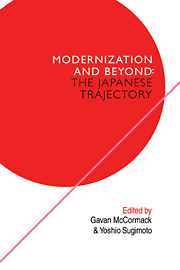Book contents
- Frontmatter
- Contents
- Contributors
- Introduction: modernization and beyond
- I Popular culture: tradition and ‘modernization’
- II Popular movements: alternative visions of ‘modernization’
- III Uneven development and its discontents
- IV Sex, politics and ‘modernity’
- 9 The Japanese women's movement: the counter-values to industrialism
- 10 Male homosexuality as treated by Japanese women writers
- 11 Body politics: abortion law reform
- 12 Division of labour: multinational sex in Asia
- V ‘Modernization’ and ‘modernity’: theoretical perspectives
- Glossary
- Index
10 - Male homosexuality as treated by Japanese women writers
Published online by Cambridge University Press: 04 August 2010
- Frontmatter
- Contents
- Contributors
- Introduction: modernization and beyond
- I Popular culture: tradition and ‘modernization’
- II Popular movements: alternative visions of ‘modernization’
- III Uneven development and its discontents
- IV Sex, politics and ‘modernity’
- 9 The Japanese women's movement: the counter-values to industrialism
- 10 Male homosexuality as treated by Japanese women writers
- 11 Body politics: abortion law reform
- 12 Division of labour: multinational sex in Asia
- V ‘Modernization’ and ‘modernity’: theoretical perspectives
- Glossary
- Index
Summary
Japanese literature has a long history of works on male homosexuality. They range from the tales of chigo (page-boys and children attached to various temples or shrines) in mediaeval times, through works on shudō (the way of male homosexuality) by Ihara Saikaku and others in the Edo Period, to modern novels like Forbidden Colours and Confessions of a Mask by Mishima Yukio. All were written by male authors.
It is only recently that female writers began to deal with the topic in literature and in shōjo manga (Japanese girls' comics). This coincided with the rise of the feminist movement, although it was not female but male homosexuality that these writers dealt with.
This paper surveys such works by female writers of both creative fields since the early 1960s. Though conventionally shōjo manga is excluded from the category of literature, there are notable similarities and mutual influence, if indirect, between the two fields in their dealing with male homosexuality. The paper discusses why the topic was chosen and how the stream changed its course from pure fantasy toward reality and from pro-paternal to anti-paternal.
In the early 1970s there was a notable change of trend in shōjo manga. With writers such as Hagio Moto, Ōshima Yumiko, and Takemiya Keiko contributing their talents, and with the backing of the somewhat more understanding and ‘liberal’ editors, the genre achieved such a great improvement in its themes and techniques that claims were made that shōjo manga had reached its own ‘Renaissance’.
- Type
- Chapter
- Information
- The Japanese TrajectoryModernization and Beyond, pp. 186 - 204Publisher: Cambridge University PressPrint publication year: 1988
- 9
- Cited by



